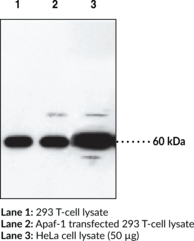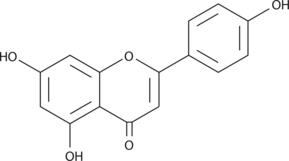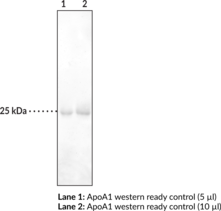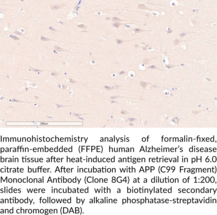Cayman
Showing 9901–10050 of 45550 results
-
AP26113 is an orally bioavailable inhibitor of anaplastic lymphoma kinase (ALK; IC50 12087), ceritinib (Item No. 19374), and CH5424802 (Item No. 18516).{31962,31296} AP26113 blocks ALK activity and reduces growth in neuroblastoma cells, mouse xenograft, and Drosophila model systems harboring constitutively active ALK variants.{31963}
Brand:CaymanSKU:19778 -Available on backorder
AP26113 is an orally bioavailable inhibitor of anaplastic lymphoma kinase (ALK; IC50 12087), ceritinib (Item No. 19374), and CH5424802 (Item No. 18516).{31962,31296} AP26113 blocks ALK activity and reduces growth in neuroblastoma cells, mouse xenograft, and Drosophila model systems harboring constitutively active ALK variants.{31963}
Brand:CaymanSKU:19778 -Available on backorder
AP26113 is an orally bioavailable inhibitor of anaplastic lymphoma kinase (ALK; IC50 12087), ceritinib (Item No. 19374), and CH5424802 (Item No. 18516).{31962,31296} AP26113 blocks ALK activity and reduces growth in neuroblastoma cells, mouse xenograft, and Drosophila model systems harboring constitutively active ALK variants.{31963}
Brand:CaymanSKU:19778 -Available on backorder
AP39 is a compound used to increase the levels of hydrogen sulfide (H2S) within mitochondria.{28632} It consists of a mitochondria-targeting motif (triphenylphosphonium) coupled to an H2S-donating moiety (dithiolethione) by an aliphatic linker. AP39 (30-300 nM) dose-dependently increases H2S levels in endothelial cells, predominantly in mitochondrial regions.{28632} It stimulates mitochondrial electron transport and improves cellular bioenergetic function at lower concentrations (30-100 nM), while having an inhibitory effect at 300 nM.{28632} Under oxidative stress conditions induced by glucose oxidase, AP39 has antioxidant and cytoprotective effects.{28632} AP39 is effective in vivo, inhibiting voltage-dependent T-type calcium channels and improving hemodynamic parameters in rats.{28633}
Brand:CaymanSKU:-Out of stock
AP39 is a compound used to increase the levels of hydrogen sulfide (H2S) within mitochondria.{28632} It consists of a mitochondria-targeting motif (triphenylphosphonium) coupled to an H2S-donating moiety (dithiolethione) by an aliphatic linker. AP39 (30-300 nM) dose-dependently increases H2S levels in endothelial cells, predominantly in mitochondrial regions.{28632} It stimulates mitochondrial electron transport and improves cellular bioenergetic function at lower concentrations (30-100 nM), while having an inhibitory effect at 300 nM.{28632} Under oxidative stress conditions induced by glucose oxidase, AP39 has antioxidant and cytoprotective effects.{28632} AP39 is effective in vivo, inhibiting voltage-dependent T-type calcium channels and improving hemodynamic parameters in rats.{28633}
Brand:CaymanSKU:-Out of stock
AP39 is a compound used to increase the levels of hydrogen sulfide (H2S) within mitochondria.{28632} It consists of a mitochondria-targeting motif (triphenylphosphonium) coupled to an H2S-donating moiety (dithiolethione) by an aliphatic linker. AP39 (30-300 nM) dose-dependently increases H2S levels in endothelial cells, predominantly in mitochondrial regions.{28632} It stimulates mitochondrial electron transport and improves cellular bioenergetic function at lower concentrations (30-100 nM), while having an inhibitory effect at 300 nM.{28632} Under oxidative stress conditions induced by glucose oxidase, AP39 has antioxidant and cytoprotective effects.{28632} AP39 is effective in vivo, inhibiting voltage-dependent T-type calcium channels and improving hemodynamic parameters in rats.{28633}
Brand:CaymanSKU:-Out of stock
AP39 is a compound used to increase the levels of hydrogen sulfide (H2S) within mitochondria.{28632} It consists of a mitochondria-targeting motif (triphenylphosphonium) coupled to an H2S-donating moiety (dithiolethione) by an aliphatic linker. AP39 (30-300 nM) dose-dependently increases H2S levels in endothelial cells, predominantly in mitochondrial regions.{28632} It stimulates mitochondrial electron transport and improves cellular bioenergetic function at lower concentrations (30-100 nM), while having an inhibitory effect at 300 nM.{28632} Under oxidative stress conditions induced by glucose oxidase, AP39 has antioxidant and cytoprotective effects.{28632} AP39 is effective in vivo, inhibiting voltage-dependent T-type calcium channels and improving hemodynamic parameters in rats.{28633}
Brand:CaymanSKU:-Out of stock
Immunogen: Synthetic peptide from an N-terminal region of human Apaf-1 • Host: Rabbit • Species Reactivity: (+) Human and mouse • Application: WB • Apaf-1 binds to cytochrome c (Apaf-2) and caspase-9 (Apaf-3), which leads to caspase-9 activation. Activated caspase-9 in turn cleaves and activates caspase-3, one of the key proteases responsible for the proteolytic cleavage of many key proteins in apoptosis. It can also associate with caspase-4 and -8.
Brand:CaymanSKU:160780- 100 µgApoptosis is related to many diseases and is induced by a family of cell death receptors and their ligands. Cell death signals are transduced by death domain containing adapter molecules and members of the caspase family of proteases. The mammalian homologues of the key cell death gene CED-4 in C. elegans has been identified recently from human and mouse and designated Apaf-1 (apoptosis protease-activating factor 1){6894,6873} Apaf-1 binds to cytochrome c (Apaf-2) and caspase-9 (Apaf-3), which leads to caspase-9 activation. Activated caspase-9 in turn cleaves and activates caspase-3, one of the key proteases responsible for the proteolytic cleavage of many key proteins in apoptosis.{6874} Apaf-1 can also associate with caspase-4 and caspase-8.{6878} Apaf-1 is ubiquitously expressed in human tissues.{6894}
Brand:CaymanSKU:160780 - 100 µgAvailable on backorder
Immunogen: Synthetic peptide from an N-terminal region of human Apaf-1 • Host: Rabbit • Species Reactivity: (+) Human and mouse • Application: WB • Apaf-1 binds to cytochrome c (Apaf-2) and caspase-9 (Apaf-3), which leads to caspase-9 activation. Activated caspase-9 in turn cleaves and activates caspase-3, one of the key proteases responsible for the proteolytic cleavage of many key proteins in apoptosis. It can also associate with caspase-4 and -8.
Brand:CaymanSKU:160780- 100 µgAvailable on backorder
Platelet-activating factor (PAF) is a biologically active phospholipid that activates platelets, polymorphonuclear leukocytes, monocytes, and macrophages.{939} PAF also increases vascular permeability, decreases cardiac output, induces hypotension, stimulates uterine contraction, and has been implicated in pathological processes, such as inflammation and allergy.{11753} Apafant is a water soluble, selective PAF receptor antagonist that inhibits PAF binding to human PAF receptors with a Ki value of 9.9 nM.{22980} Apafant displays anti-inflammatory, antiangiogenic, and anticancer activity.{22981,22980,16870}
Brand:CaymanSKU:-Platelet-activating factor (PAF) is a biologically active phospholipid that activates platelets, polymorphonuclear leukocytes, monocytes, and macrophages.{939} PAF also increases vascular permeability, decreases cardiac output, induces hypotension, stimulates uterine contraction, and has been implicated in pathological processes, such as inflammation and allergy.{11753} Apafant is a water soluble, selective PAF receptor antagonist that inhibits PAF binding to human PAF receptors with a Ki value of 9.9 nM.{22980} Apafant displays anti-inflammatory, antiangiogenic, and anticancer activity.{22981,22980,16870}
Brand:CaymanSKU:-Apamin is an 18 amino acid peptide toxin found in bee venom. It is a potent blocker of small conductance Ca2+-activated K+ (SK, KCa2) channels that is more effective at SK2 than SK1 and SK3 (IC50 values are 0.06-0.4, 1-12, and 1-13 nM, respectively).{27792,27794} It is ineffective against SK4 at 1 µM.{27794} Apamin is used to elucidate the roles of these channels in cells and tissues expressing SK channels, including neurons, vascular endothelium, bladder smooth muscle, and certain types of cancer cells.{27791,27789,27790,27793}
Brand:CaymanSKU:-Out of stock
Apatinib is a tyrosine kinase inhibitor that potently suppresses the kinase activity of vascular endothelial growth factor 2 (VEGFR2; IC50 = 1 nM).{33574} It is less effective against c-kit (IC50 = 429 nM), Ret (IC50 = 13 nM), and c-src (IC50 = 53 nM) and does not inhibit EGFR, Her-2, or FGFR1 (IC50s = >10 µM).{33574} Apatinib has been shown to inhibit the proliferation, migration, and tube formation of human umbilical vein endothelial cells stimulated by fetal bovine serum and, either alone, or in combination with chemotherapeutic agents, prevented the growth of several established human tumor xenograft models.{33574}
Brand:CaymanSKU:21268 -Out of stock
Apatinib is a tyrosine kinase inhibitor that potently suppresses the kinase activity of vascular endothelial growth factor 2 (VEGFR2; IC50 = 1 nM).{33574} It is less effective against c-kit (IC50 = 429 nM), Ret (IC50 = 13 nM), and c-src (IC50 = 53 nM) and does not inhibit EGFR, Her-2, or FGFR1 (IC50s = >10 µM).{33574} Apatinib has been shown to inhibit the proliferation, migration, and tube formation of human umbilical vein endothelial cells stimulated by fetal bovine serum and, either alone, or in combination with chemotherapeutic agents, prevented the growth of several established human tumor xenograft models.{33574}
Brand:CaymanSKU:21268 -Out of stock
Apatinib is a tyrosine kinase inhibitor that potently suppresses the kinase activity of vascular endothelial growth factor 2 (VEGFR2; IC50 = 1 nM).{33574} It is less effective against c-kit (IC50 = 429 nM), Ret (IC50 = 13 nM), and c-src (IC50 = 53 nM) and does not inhibit EGFR, Her-2, or FGFR1 (IC50s = >10 µM).{33574} Apatinib has been shown to inhibit the proliferation, migration, and tube formation of human umbilical vein endothelial cells stimulated by fetal bovine serum and, either alone, or in combination with chemotherapeutic agents, prevented the growth of several established human tumor xenograft models.{33574}
Brand:CaymanSKU:21268 -Out of stock
Apatinib is a tyrosine kinase inhibitor that potently suppresses the kinase activity of vascular endothelial growth factor 2 (VEGFR2; IC50 = 1 nM).{33574} It is less effective against c-kit (IC50 = 429 nM), Ret (IC50 = 13 nM), and c-src (IC50 = 53 nM) and does not inhibit EGFR, Her-2, or FGFR1 (IC50s = >10 µM).{33574} Apatinib has been shown to inhibit the proliferation, migration, and tube formation of human umbilical vein endothelial cells stimulated by fetal bovine serum and, either alone, or in combination with chemotherapeutic agents, prevented the growth of several established human tumor xenograft models.{33574}
Brand:CaymanSKU:21268 -Out of stock
Apcin is an inhibitor of the E3 ligase activity of the mitotic anaphase-promoting complex/cyclosome (APC/C). Apcin competitively binds to Cdc20 and prevents substrate interaction and ubiquitylation required for continuation of mitosis.{36287} Apcin enhances the effect of the APC/C inhibitor N-4-tosyl-L-arginine methyl ester (TAME; Item No. 17550) and its prodrug, proTAME, leading to an increase in the number of cells in mitosis, a longer mitotic duration, and greater stabilization of cyclin B1, cycB1-NT, securin, and cyclin A2.{36287} Apcin, in combination with proTAME, synergistically increases apoptosis in multiple myeloma cells.{36286}
Brand:CaymanSKU:-Out of stock
Apcin is an inhibitor of the E3 ligase activity of the mitotic anaphase-promoting complex/cyclosome (APC/C). Apcin competitively binds to Cdc20 and prevents substrate interaction and ubiquitylation required for continuation of mitosis.{36287} Apcin enhances the effect of the APC/C inhibitor N-4-tosyl-L-arginine methyl ester (TAME; Item No. 17550) and its prodrug, proTAME, leading to an increase in the number of cells in mitosis, a longer mitotic duration, and greater stabilization of cyclin B1, cycB1-NT, securin, and cyclin A2.{36287} Apcin, in combination with proTAME, synergistically increases apoptosis in multiple myeloma cells.{36286}
Brand:CaymanSKU:-Out of stock
Apcin is an inhibitor of the E3 ligase activity of the mitotic anaphase-promoting complex/cyclosome (APC/C). Apcin competitively binds to Cdc20 and prevents substrate interaction and ubiquitylation required for continuation of mitosis.{36287} Apcin enhances the effect of the APC/C inhibitor N-4-tosyl-L-arginine methyl ester (TAME; Item No. 17550) and its prodrug, proTAME, leading to an increase in the number of cells in mitosis, a longer mitotic duration, and greater stabilization of cyclin B1, cycB1-NT, securin, and cyclin A2.{36287} Apcin, in combination with proTAME, synergistically increases apoptosis in multiple myeloma cells.{36286}
Brand:CaymanSKU:-Out of stock
Apcin is an inhibitor of the E3 ligase activity of the mitotic anaphase-promoting complex/cyclosome (APC/C). Apcin competitively binds to Cdc20 and prevents substrate interaction and ubiquitylation required for continuation of mitosis.{36287} Apcin enhances the effect of the APC/C inhibitor N-4-tosyl-L-arginine methyl ester (TAME; Item No. 17550) and its prodrug, proTAME, leading to an increase in the number of cells in mitosis, a longer mitotic duration, and greater stabilization of cyclin B1, cycB1-NT, securin, and cyclin A2.{36287} Apcin, in combination with proTAME, synergistically increases apoptosis in multiple myeloma cells.{36286}
Brand:CaymanSKU:-Out of stock
APD597 is an orally bioavailable agonist of GPR119 that has EC50 values of 46 and 421 nM for the human and rat receptors, respectively, in a homologous time-resolved fluorescence (HTRF) assay.{48588} It increases insulin secretion stimulated by a high, but not low, concentration of glucose in isolated mouse pancreatic β-cells and in isolated human islets.{48589} APD597 (20 mg/kg) increases levels of glucagon-like peptide-1 (GLP-1; Item No. 24460) induced by glucose in mice. It also decreases blood glucose levels in an oral glucose tolerance test in mice when administered at doses of 1 and 10 mg/kg and in Zucker diabetic rats at a dose of 3 mg/kg.{48588}
Brand:CaymanSKU:22950 - 10 mgAvailable on backorder
APD597 is an orally bioavailable agonist of GPR119 that has EC50 values of 46 and 421 nM for the human and rat receptors, respectively, in a homologous time-resolved fluorescence (HTRF) assay.{48588} It increases insulin secretion stimulated by a high, but not low, concentration of glucose in isolated mouse pancreatic β-cells and in isolated human islets.{48589} APD597 (20 mg/kg) increases levels of glucagon-like peptide-1 (GLP-1; Item No. 24460) induced by glucose in mice. It also decreases blood glucose levels in an oral glucose tolerance test in mice when administered at doses of 1 and 10 mg/kg and in Zucker diabetic rats at a dose of 3 mg/kg.{48588}
Brand:CaymanSKU:22950 - 25 mgAvailable on backorder
APD597 is an orally bioavailable agonist of GPR119 that has EC50 values of 46 and 421 nM for the human and rat receptors, respectively, in a homologous time-resolved fluorescence (HTRF) assay.{48588} It increases insulin secretion stimulated by a high, but not low, concentration of glucose in isolated mouse pancreatic β-cells and in isolated human islets.{48589} APD597 (20 mg/kg) increases levels of glucagon-like peptide-1 (GLP-1; Item No. 24460) induced by glucose in mice. It also decreases blood glucose levels in an oral glucose tolerance test in mice when administered at doses of 1 and 10 mg/kg and in Zucker diabetic rats at a dose of 3 mg/kg.{48588}
Brand:CaymanSKU:22950 - 5 mgAvailable on backorder
APD597 is an orally bioavailable agonist of GPR119 that has EC50 values of 46 and 421 nM for the human and rat receptors, respectively, in a homologous time-resolved fluorescence (HTRF) assay.{48588} It increases insulin secretion stimulated by a high, but not low, concentration of glucose in isolated mouse pancreatic β-cells and in isolated human islets.{48589} APD597 (20 mg/kg) increases levels of glucagon-like peptide-1 (GLP-1; Item No. 24460) induced by glucose in mice. It also decreases blood glucose levels in an oral glucose tolerance test in mice when administered at doses of 1 and 10 mg/kg and in Zucker diabetic rats at a dose of 3 mg/kg.{48588}
Brand:CaymanSKU:22950 - 50 mgAvailable on backorder
GPR119, a glucose-dependent insulinotropic receptor, is a G protein-coupled receptor that is expressed in pancreatic β-cells and intestinal L-cells.{14046} Activation of GPR119 by the endogenous ligands lyso-phosphatidylcholine (Item No. 10172) and oleoyl ethanolamide (Item No. 90265) increases intracellular cAMP levels and promotes glucose-stimulated insulin secretion.{14046,18880} APD668 is a potent agonist of GPR119 (EC50s = 2.7 and 33 nM for human and rat forms, respectively).{28680} Chronic dosing with APD668 in Zucker diabetic fatty rats over several weeks significantly reduces blood glucose and glycated hemoglobin levels.{28680}
Brand:CaymanSKU:-Available on backorder
GPR119, a glucose-dependent insulinotropic receptor, is a G protein-coupled receptor that is expressed in pancreatic β-cells and intestinal L-cells.{14046} Activation of GPR119 by the endogenous ligands lyso-phosphatidylcholine (Item No. 10172) and oleoyl ethanolamide (Item No. 90265) increases intracellular cAMP levels and promotes glucose-stimulated insulin secretion.{14046,18880} APD668 is a potent agonist of GPR119 (EC50s = 2.7 and 33 nM for human and rat forms, respectively).{28680} Chronic dosing with APD668 in Zucker diabetic fatty rats over several weeks significantly reduces blood glucose and glycated hemoglobin levels.{28680}
Brand:CaymanSKU:-Available on backorder
GPR119, a glucose-dependent insulinotropic receptor, is a G protein-coupled receptor that is expressed in pancreatic β-cells and intestinal L-cells.{14046} Activation of GPR119 by the endogenous ligands lyso-phosphatidylcholine (Item No. 10172) and oleoyl ethanolamide (Item No. 90265) increases intracellular cAMP levels and promotes glucose-stimulated insulin secretion.{14046,18880} APD668 is a potent agonist of GPR119 (EC50s = 2.7 and 33 nM for human and rat forms, respectively).{28680} Chronic dosing with APD668 in Zucker diabetic fatty rats over several weeks significantly reduces blood glucose and glycated hemoglobin levels.{28680}
Brand:CaymanSKU:-Available on backorder
The apelin gene encodes a preproprotein that is processed to generate a variety of bioactive peptides, including those having 36, 17, or 13 amino acids (apelin-36, apelin-17, and apelin-13, respectively). The apelin proteins are the endogenous ligands of the G protein-coupled receptor, APJ.{18228,18229} Apelin-36 is the full-length mature peptide produced from the translated 77 amino acid prepropeptide. The apelins act primarily in the peripheral and central nervous system, playing important roles in regulating cardiovascular function, fluid homeostasis, hypertension, and insulin sensitivity.{18229} Apelin-36 is a less potent agonist of APJ than either apelin-17 or apelin-13 (EC50 = 20, 2.5, and 0.37 nM, respectively).{18227,18228} Apelin-36 potently inhibits HIV-1 entry into cells expressing APJ and CD4, limiting HIV infection.{18226}
Brand:CaymanSKU:-The apelin gene encodes a preproprotein that is processed to generate a variety of bioactive peptides, including those having 36, 17, or 13 amino acids (apelin-36, apelin-17, and apelin-13, respectively). The apelin proteins are the endogenous ligands of the G protein-coupled receptor, APJ.{18228,18229} Apelin-36 is the full-length mature peptide produced from the translated 77 amino acid prepropeptide. The apelins act primarily in the peripheral and central nervous system, playing important roles in regulating cardiovascular function, fluid homeostasis, hypertension, and insulin sensitivity.{18229} Apelin-36 is a less potent agonist of APJ than either apelin-17 or apelin-13 (EC50 = 20, 2.5, and 0.37 nM, respectively).{18227,18228} Apelin-36 potently inhibits HIV-1 entry into cells expressing APJ and CD4, limiting HIV infection.{18226}
Brand:CaymanSKU:-The apelin gene encodes a preproprotein that is processed to generate a variety of bioactive peptides, including those having 36, 17, or 13 amino acids (apelin-36, apelin-17, and apelin-13, respectively). The apelin proteins are the endogenous ligands of the G protein-coupled receptor, APJ.{18228,18229} Apelin-36 is the full-length mature peptide produced from the translated 77 amino acid prepropeptide. The apelins act primarily in the peripheral and central nervous system, playing important roles in regulating cardiovascular function, fluid homeostasis, hypertension, and insulin sensitivity.{18229} Apelin-36 is a less potent agonist of APJ than either apelin-17 or apelin-13 (EC50 = 20, 2.5, and 0.37 nM, respectively).{18227,18228} Apelin-36 potently inhibits HIV-1 entry into cells expressing APJ and CD4, limiting HIV infection.{18226}
Brand:CaymanSKU:-APF is an aromatic amino-fluorescein derivative and fluorescent probe for highly reactive radicals.{11242} It has low intrinsic fluorescence, however, upon oxidation by hydroxyl radical, hypochlorite ion, and certain peroxidase intermediates, it is converted to the highly fluorescent molecule fluorescein, facilitating the detection of highly reactive biological radicals.{11242} APF is not oxidized by nitric oxide (NO), hydrogen peroxide (H2O2), or other oxidants. Fluorescein displays excitation/emission maxima of 490/515 nm, respectively.
Brand:CaymanSKU:10157 - 1 mgAvailable on backorder
APF is an aromatic amino-fluorescein derivative and fluorescent probe for highly reactive radicals.{11242} It has low intrinsic fluorescence, however, upon oxidation by hydroxyl radical, hypochlorite ion, and certain peroxidase intermediates, it is converted to the highly fluorescent molecule fluorescein, facilitating the detection of highly reactive biological radicals.{11242} APF is not oxidized by nitric oxide (NO), hydrogen peroxide (H2O2), or other oxidants. Fluorescein displays excitation/emission maxima of 490/515 nm, respectively.
Brand:CaymanSKU:10157 - 5 mgAvailable on backorder
APF is an aromatic amino-fluorescein derivative and fluorescent probe for highly reactive radicals.{11242} It has low intrinsic fluorescence, however, upon oxidation by hydroxyl radical, hypochlorite ion, and certain peroxidase intermediates, it is converted to the highly fluorescent molecule fluorescein, facilitating the detection of highly reactive biological radicals.{11242} APF is not oxidized by nitric oxide (NO), hydrogen peroxide (H2O2), or other oxidants. Fluorescein displays excitation/emission maxima of 490/515 nm, respectively.
Brand:CaymanSKU:10157 - 500 µgAvailable on backorder
APHA compound 8 is an inhibitor of class I histone deacetylases (HDACs; IC50s = 3.7, 7.4, 0.42, and 2.8 μM for HDAC1, -2, -3, and -8, respectively) as well as class II HDACs (IC50s = 3.1, 0.1, 3.1, and 4.2 μM for HDAC4, -6, -7, and -10, respectively).{46978} It is selective for class I and II HDACs over class III HDACs (IC50s = >30 μM for SIRT1, SIRT2, and SIRT3) and the histone acetyltransferase PCAF (IC50 = >30 μM). At 48 hours post-infection, APHA compound 8 increases replication of oncolytic herpes simplex virus (oHSV) in MDA-MB-231 and 4T1 breast cancer cells when used prior to viral infection at concentrations of 10 and 50 μM.{46979}
Brand:CaymanSKU:21228 -Out of stock
APHA compound 8 is an inhibitor of class I histone deacetylases (HDACs; IC50s = 3.7, 7.4, 0.42, and 2.8 μM for HDAC1, -2, -3, and -8, respectively) as well as class II HDACs (IC50s = 3.1, 0.1, 3.1, and 4.2 μM for HDAC4, -6, -7, and -10, respectively).{46978} It is selective for class I and II HDACs over class III HDACs (IC50s = >30 μM for SIRT1, SIRT2, and SIRT3) and the histone acetyltransferase PCAF (IC50 = >30 μM). At 48 hours post-infection, APHA compound 8 increases replication of oncolytic herpes simplex virus (oHSV) in MDA-MB-231 and 4T1 breast cancer cells when used prior to viral infection at concentrations of 10 and 50 μM.{46979}
Brand:CaymanSKU:21228 -Out of stock
API-1 is an inhibitor of Akt that reduces the level of phosphorylated Akt (IC50 = ~0.8 µM in OVCAR3 cells) by binding to Akt and blocking its translocation to the cell membrane.{37133} It reduces cell proliferation in various cancer cell lines, induces apoptosis, and, at a dose of 10 mg/kg per day, decreases tumor growth in a mouse xenograft model. API-1 inhibition of Akt leads to proteasomal degradation of the downstream mediator Mcl-1.{37132} Likely independent of Akt binding, API-1 inhibits cell growth (IC50s = 2-5 µM) and induces apoptosis in non-small cell lung and head and neck squamous cancer (NSCLC and HNSCC) cell lines with concomitant increases in caspase-3, -8, and -9 cleavage.{37131} It reduces the levels of cellular FLICE-inhibitory protein (c-FLIP), an important regulator of apoptosis, through ubiquitin- and proteasome-mediated degradation. It also has a synergistic effect on apoptosis in combination with TRAIL/APO-2L. The information regarding the reduction in phosphorylated Akt levels, IC50 value, translocation, cell proliferation, and xenograft tumor growth was drawn from a paper that has been retracted; however, the information specified in the retraction statement has not been included.{37133}
Brand:CaymanSKU:22081 -Out of stock
API-1 is an inhibitor of Akt that reduces the level of phosphorylated Akt (IC50 = ~0.8 µM in OVCAR3 cells) by binding to Akt and blocking its translocation to the cell membrane.{37133} It reduces cell proliferation in various cancer cell lines, induces apoptosis, and, at a dose of 10 mg/kg per day, decreases tumor growth in a mouse xenograft model. API-1 inhibition of Akt leads to proteasomal degradation of the downstream mediator Mcl-1.{37132} Likely independent of Akt binding, API-1 inhibits cell growth (IC50s = 2-5 µM) and induces apoptosis in non-small cell lung and head and neck squamous cancer (NSCLC and HNSCC) cell lines with concomitant increases in caspase-3, -8, and -9 cleavage.{37131} It reduces the levels of cellular FLICE-inhibitory protein (c-FLIP), an important regulator of apoptosis, through ubiquitin- and proteasome-mediated degradation. It also has a synergistic effect on apoptosis in combination with TRAIL/APO-2L. The information regarding the reduction in phosphorylated Akt levels, IC50 value, translocation, cell proliferation, and xenograft tumor growth was drawn from a paper that has been retracted; however, the information specified in the retraction statement has not been included.{37133}
Brand:CaymanSKU:22081 -Out of stock
API-1 is an inhibitor of Akt that reduces the level of phosphorylated Akt (IC50 = ~0.8 µM in OVCAR3 cells) by binding to Akt and blocking its translocation to the cell membrane.{37133} It reduces cell proliferation in various cancer cell lines, induces apoptosis, and, at a dose of 10 mg/kg per day, decreases tumor growth in a mouse xenograft model. API-1 inhibition of Akt leads to proteasomal degradation of the downstream mediator Mcl-1.{37132} Likely independent of Akt binding, API-1 inhibits cell growth (IC50s = 2-5 µM) and induces apoptosis in non-small cell lung and head and neck squamous cancer (NSCLC and HNSCC) cell lines with concomitant increases in caspase-3, -8, and -9 cleavage.{37131} It reduces the levels of cellular FLICE-inhibitory protein (c-FLIP), an important regulator of apoptosis, through ubiquitin- and proteasome-mediated degradation. It also has a synergistic effect on apoptosis in combination with TRAIL/APO-2L. The information regarding the reduction in phosphorylated Akt levels, IC50 value, translocation, cell proliferation, and xenograft tumor growth was drawn from a paper that has been retracted; however, the information specified in the retraction statement has not been included.{37133}
Brand:CaymanSKU:22081 -Out of stock
Histone acetyltransferase and histone deacetylase (HDAC) activity regulates the reversible acetylation of lysine residues within histone tails, which results in either transcriptional activation or repression of nearby genes. Compounds that modulate this activity are of interest in cancer chemotherapeutics as well as for treating psychiatric disorders, malaria, and other diseases. Apicidin is a fungal toxin that has broad spectrum activity against Apicomplexan parasites through inhibiting HDACs (IC50 = 0.7 nM).{18472} An in vitro activity assay demonstrates apicidin inhibition of HDAC3/NCoR, a class I HDAC, at a much higher potency than for class II HDAC6 (IC50s = 15.8 and 665.1 nM, respectively).{15938} Apicidin exhibits antiproliferative activity against various cancer cell lines (IC50s = 0.13-2.36 μM), and at 0.5 – 2 μM it induces selective changes in p21WAF1/Cip1 and gelsolin gene expression, which control cell cycle and cell morphology, respectively.{18467}
Brand:CaymanSKU:10575 - 1 mgAvailable on backorder
Histone acetyltransferase and histone deacetylase (HDAC) activity regulates the reversible acetylation of lysine residues within histone tails, which results in either transcriptional activation or repression of nearby genes. Compounds that modulate this activity are of interest in cancer chemotherapeutics as well as for treating psychiatric disorders, malaria, and other diseases. Apicidin is a fungal toxin that has broad spectrum activity against Apicomplexan parasites through inhibiting HDACs (IC50 = 0.7 nM).{18472} An in vitro activity assay demonstrates apicidin inhibition of HDAC3/NCoR, a class I HDAC, at a much higher potency than for class II HDAC6 (IC50s = 15.8 and 665.1 nM, respectively).{15938} Apicidin exhibits antiproliferative activity against various cancer cell lines (IC50s = 0.13-2.36 μM), and at 0.5 – 2 μM it induces selective changes in p21WAF1/Cip1 and gelsolin gene expression, which control cell cycle and cell morphology, respectively.{18467}
Brand:CaymanSKU:10575 - 10 mgAvailable on backorder
Histone acetyltransferase and histone deacetylase (HDAC) activity regulates the reversible acetylation of lysine residues within histone tails, which results in either transcriptional activation or repression of nearby genes. Compounds that modulate this activity are of interest in cancer chemotherapeutics as well as for treating psychiatric disorders, malaria, and other diseases. Apicidin is a fungal toxin that has broad spectrum activity against Apicomplexan parasites through inhibiting HDACs (IC50 = 0.7 nM).{18472} An in vitro activity assay demonstrates apicidin inhibition of HDAC3/NCoR, a class I HDAC, at a much higher potency than for class II HDAC6 (IC50s = 15.8 and 665.1 nM, respectively).{15938} Apicidin exhibits antiproliferative activity against various cancer cell lines (IC50s = 0.13-2.36 μM), and at 0.5 – 2 μM it induces selective changes in p21WAF1/Cip1 and gelsolin gene expression, which control cell cycle and cell morphology, respectively.{18467}
Brand:CaymanSKU:10575 - 5 mgAvailable on backorder
Apigenin is a flavonoid compound found in many fruits and vegetables that selectively inhibits casein kinase 2 (CK2). Apigenin inhibits CK2 activity in the renal cortex with an IC50 value of 30 µM to improve renal function in a rat model of glomerulonephritis.{15364} CK2 inhibition by 20 µM apigenin decreases the degradation of IκBα and down-regulates NF-κB levels in WEHI-231 cells.{15361} Apigenin at 5 µM is a potent inhibitor of the synthesis of the inflammatory mediators nitric oxide and prostaglandin E2, reducing inducible nitric oxide synthase (iNOS) and cyclooxygenase-2 (COX-2) expression by 56% and 64%, respectively, in the macrophage cell line J774A.1.{15362}
Brand:CaymanSKU:10010275 - 100 mgAvailable on backorder
Apigenin is a flavonoid compound found in many fruits and vegetables that selectively inhibits casein kinase 2 (CK2). Apigenin inhibits CK2 activity in the renal cortex with an IC50 value of 30 µM to improve renal function in a rat model of glomerulonephritis.{15364} CK2 inhibition by 20 µM apigenin decreases the degradation of IκBα and down-regulates NF-κB levels in WEHI-231 cells.{15361} Apigenin at 5 µM is a potent inhibitor of the synthesis of the inflammatory mediators nitric oxide and prostaglandin E2, reducing inducible nitric oxide synthase (iNOS) and cyclooxygenase-2 (COX-2) expression by 56% and 64%, respectively, in the macrophage cell line J774A.1.{15362}
Brand:CaymanSKU:10010275 - 25 mgAvailable on backorder
Apigenin is a flavonoid compound found in many fruits and vegetables that selectively inhibits casein kinase 2 (CK2). Apigenin inhibits CK2 activity in the renal cortex with an IC50 value of 30 µM to improve renal function in a rat model of glomerulonephritis.{15364} CK2 inhibition by 20 µM apigenin decreases the degradation of IκBα and down-regulates NF-κB levels in WEHI-231 cells.{15361} Apigenin at 5 µM is a potent inhibitor of the synthesis of the inflammatory mediators nitric oxide and prostaglandin E2, reducing inducible nitric oxide synthase (iNOS) and cyclooxygenase-2 (COX-2) expression by 56% and 64%, respectively, in the macrophage cell line J774A.1.{15362}
Brand:CaymanSKU:10010275 - 50 mgAvailable on backorder
Apigenin is a flavonoid compound found in many fruits and vegetables that selectively inhibits casein kinase 2 (CK2). Apigenin inhibits CK2 activity in the renal cortex with an IC50 value of 30 µM to improve renal function in a rat model of glomerulonephritis.{15364} CK2 inhibition by 20 µM apigenin decreases the degradation of IκBα and down-regulates NF-κB levels in WEHI-231 cells.{15361} Apigenin at 5 µM is a potent inhibitor of the synthesis of the inflammatory mediators nitric oxide and prostaglandin E2, reducing inducible nitric oxide synthase (iNOS) and cyclooxygenase-2 (COX-2) expression by 56% and 64%, respectively, in the macrophage cell line J774A.1.{15362}
Brand:CaymanSKU:10010275 - 500 mgAvailable on backorder
Apigenin 7-glucoside is a flavonoid with anti-inflammatory and anxiolytic activities.{47248,47249} It inhibits LPS-induced nitric oxide production in RAW 264.7 cells when used at concentrations ranging from 0.16 to 10 μM.{47248} In vivo, apigenin 7-glucoside (10 mg/kg) reduces pulmonary edema and lung inflammation in a mouse model of LPS-induced acute lung injury. It also increases the number of entries and the time spent in the open arms of the elevated plus maze in rats, indicating anxiolytic activity.{47249}
Brand:CaymanSKU:26813 - 10 mgAvailable on backorder
Apigenin 7-glucoside is a flavonoid with anti-inflammatory and anxiolytic activities.{47248,47249} It inhibits LPS-induced nitric oxide production in RAW 264.7 cells when used at concentrations ranging from 0.16 to 10 μM.{47248} In vivo, apigenin 7-glucoside (10 mg/kg) reduces pulmonary edema and lung inflammation in a mouse model of LPS-induced acute lung injury. It also increases the number of entries and the time spent in the open arms of the elevated plus maze in rats, indicating anxiolytic activity.{47249}
Brand:CaymanSKU:26813 - 25 mgAvailable on backorder
Apigenin 7-glucoside is a flavonoid with anti-inflammatory and anxiolytic activities.{47248,47249} It inhibits LPS-induced nitric oxide production in RAW 264.7 cells when used at concentrations ranging from 0.16 to 10 μM.{47248} In vivo, apigenin 7-glucoside (10 mg/kg) reduces pulmonary edema and lung inflammation in a mouse model of LPS-induced acute lung injury. It also increases the number of entries and the time spent in the open arms of the elevated plus maze in rats, indicating anxiolytic activity.{47249}
Brand:CaymanSKU:26813 - 5 mgAvailable on backorder
Apigenin 7-glucoside is a flavonoid with anti-inflammatory and anxiolytic activities.{47248,47249} It inhibits LPS-induced nitric oxide production in RAW 264.7 cells when used at concentrations ranging from 0.16 to 10 μM.{47248} In vivo, apigenin 7-glucoside (10 mg/kg) reduces pulmonary edema and lung inflammation in a mouse model of LPS-induced acute lung injury. It also increases the number of entries and the time spent in the open arms of the elevated plus maze in rats, indicating anxiolytic activity.{47249}
Brand:CaymanSKU:26813 - 50 mgAvailable on backorder
Apigenin-d5 is an internal standard for the quantificaiton of apigenin (Item No. 10010275) by GC- or LC-MS. Apigenin is a flavonoid compound found in many fruits and vegetables that selectively inhibits casein kinase 2 (CK2). Apigenin inhibits CK2 activity in the renal cortex with an IC50 value of 30 µM to improve renal function in a rat model of glomerulonephritis.{15364} CK2 inhibition by 20 µM apigenin decreases the degradation of IκBα and down-regulates NF-κB levels in WEHI-231 cells.{15361} Apigenin, at 5 µM, is a potent inhibitor of the synthesis of the inflammatory mediators nitric oxide and prostaglandin E2, reducing inducible nitric oxide synthase (iNOS) and cyclooxygenase-2 (COX-2) expression by 56% and 64%, respectively, in the macrophage cell line J774A.1.{15362}
Brand:CaymanSKU:22106 -Out of stock
Apigenin-d5 is an internal standard for the quantificaiton of apigenin (Item No. 10010275) by GC- or LC-MS. Apigenin is a flavonoid compound found in many fruits and vegetables that selectively inhibits casein kinase 2 (CK2). Apigenin inhibits CK2 activity in the renal cortex with an IC50 value of 30 µM to improve renal function in a rat model of glomerulonephritis.{15364} CK2 inhibition by 20 µM apigenin decreases the degradation of IκBα and down-regulates NF-κB levels in WEHI-231 cells.{15361} Apigenin, at 5 µM, is a potent inhibitor of the synthesis of the inflammatory mediators nitric oxide and prostaglandin E2, reducing inducible nitric oxide synthase (iNOS) and cyclooxygenase-2 (COX-2) expression by 56% and 64%, respectively, in the macrophage cell line J774A.1.{15362}
Brand:CaymanSKU:22106 -Out of stock
Apigeninidin is a natural 3-deoxyanthocyanidin that can be isolated from leaves of sorghum.{33556} The synthesis of apigeninidin is increased, particularly in leaves of S. bicolor, after wounding or pathogen invasion, resulting in purple coloration.{33554} Apigeninidin has antibiotic and antifungal properties.{33555,33557} It can be used to stain collagen fibers, muscles, and red blood cells in animal tissue sections.{33553}
Brand:CaymanSKU:19756 -Available on backorder
Apigeninidin is a natural 3-deoxyanthocyanidin that can be isolated from leaves of sorghum.{33556} The synthesis of apigeninidin is increased, particularly in leaves of S. bicolor, after wounding or pathogen invasion, resulting in purple coloration.{33554} Apigeninidin has antibiotic and antifungal properties.{33555,33557} It can be used to stain collagen fibers, muscles, and red blood cells in animal tissue sections.{33553}
Brand:CaymanSKU:19756 -Available on backorder
Apixaban is an orally bioavailable, selective inhibitor of both free and prothrombinase-bound factor Xa (Kis = 0.8 nM).{25094} In vivo, apixaban has antithrombotic effects in a rabbit model of venous thrombosis. Apixaban (357.5 mg) also prevents thrombus formation without inducing adverse bleeding events in a porcine model of aortic heterotopic valve replacement.{36697} Formulations containing apixaban have been used to prevent blood clot formation in patients with atrial fibrillation.
Brand:CaymanSKU:-Apixaban is an orally bioavailable, selective inhibitor of both free and prothrombinase-bound factor Xa (Kis = 0.8 nM).{25094} In vivo, apixaban has antithrombotic effects in a rabbit model of venous thrombosis. Apixaban (357.5 mg) also prevents thrombus formation without inducing adverse bleeding events in a porcine model of aortic heterotopic valve replacement.{36697} Formulations containing apixaban have been used to prevent blood clot formation in patients with atrial fibrillation.
Brand:CaymanSKU:-Apixaban is an orally bioavailable, selective inhibitor of both free and prothrombinase-bound factor Xa (Kis = 0.8 nM).{25094} In vivo, apixaban has antithrombotic effects in a rabbit model of venous thrombosis. Apixaban (357.5 mg) also prevents thrombus formation without inducing adverse bleeding events in a porcine model of aortic heterotopic valve replacement.{36697} Formulations containing apixaban have been used to prevent blood clot formation in patients with atrial fibrillation.
Brand:CaymanSKU:-Apixaban is an orally bioavailable, selective inhibitor of both free and prothrombinase-bound factor Xa (Kis = 0.8 nM).{25094} In vivo, apixaban has antithrombotic effects in a rabbit model of venous thrombosis. Apixaban (357.5 mg) also prevents thrombus formation without inducing adverse bleeding events in a porcine model of aortic heterotopic valve replacement.{36697} Formulations containing apixaban have been used to prevent blood clot formation in patients with atrial fibrillation.
Brand:CaymanSKU:-Apixaban-13C-d3 is intended for use as an internal standard for the quantification of apixaban (Item No. 15427) by GC- or LC-MS. Apixaban is an orally bioavailable, selective inhibitor of both free and prothrombinase-bound factor Xa (Kis = 0.8 nM).{25094} In vivo, apixaban has antithrombotic effects in a rabbit model of venous thrombosis.
Brand:CaymanSKU:25034 - 1 mgAvailable on backorder
Apixaban-13C-d3 is intended for use as an internal standard for the quantification of apixaban (Item No. 15427) by GC- or LC-MS. Apixaban is an orally bioavailable, selective inhibitor of both free and prothrombinase-bound factor Xa (Kis = 0.8 nM).{25094} In vivo, apixaban has antithrombotic effects in a rabbit model of venous thrombosis.
Brand:CaymanSKU:25034 - 5 mgAvailable on backorder
Apixaban-13C-d3 is intended for use as an internal standard for the quantification of apixaban (Item No. 15427) by GC- or LC-MS. Apixaban is an orally bioavailable, selective inhibitor of both free and prothrombinase-bound factor Xa (Kis = 0.8 nM).{25094} In vivo, apixaban has antithrombotic effects in a rabbit model of venous thrombosis.
Brand:CaymanSKU:25034 - 500 µgAvailable on backorder
Antigen: human ApoA1 amino acids 188-199 • Host: mouse, clone CC3821C4 • Cross Reactivity: (+) human ApoA1, (−) ApoB • Application(s): WB • ApoA1 is a major protein component of HDL. It acts as an acceptor for sequential transfers of phospholipids and free cholesterol from peripheral tissues and transports cholesterol to the liver and other tissues for excretion and steroidogenesis.
Brand:CaymanSKU:13042- 1 eaAvailable on backorder
Antigen: human ApoA1 amino acids 188-199 • Host: mouse, clone CC3821C4 • Cross Reactivity: (+) human ApoA1, (−) ApoB • Application(s): WB • ApoA1 is a major protein component of HDL. It acts as an acceptor for sequential transfers of phospholipids and free cholesterol from peripheral tissues and transports cholesterol to the liver and other tissues for excretion and steroidogenesis.
Brand:CaymanSKU:13042- 1 eaApoA1 is a major protein component in high-density lipoproteins (HDLs). It acts as an acceptor for sequential transfers of phospholipids and free cholesterol from peripheral tissues and transports cholesterol to the liver and other tissues for excretion and steroidogenesis.{14038} Serum ApoA1 levels are inversely related to the risk of developing atherosclerosis.{14039} Loss-of-function mutations are causes of diseases such as HDL deficiency type 1 (or Tangier disease) and type 2 (familial hypoalphalipoproteinemia), and systemic non-neuropathic amyloidosis.{14037,14040} Liver and small intestine are two main sources of the protein. ApoA1 is comprised of a single polypeptide chain of 243 amino acid residues with an estimated molecular weight of 28 kDa. Cayman’s ApoA1 Monoclonal Antibody detects the protein from diluted human plasma (≤10 µg total protein) by western blotting. Western blotting of recombinant ApoA1 samples suggest a detection limit of 5 ng.
Brand:CaymanSKU:13042 - 1 eaAvailable on backorder
ApoA1 is a major protein component in high-density lipoproteins (HDLs). It acts as an acceptor for sequential transfers of phospholipids and free cholesterol from peripheral tissues as well as transporting cholesterol to the liver and other tissues for excretion and steroidogenesis.{14038} Serum ApoA1 levels are inversely related to the risk of developing atherosclerosis.{14039} Loss-of-function mutations in ApoA1 are causes of diseases such as HDL deficiency type 1 (or Tangier disease) and type 2 (familial hypoalphalipoproteinemia), and systemic non-neuropathic amyloidosis.{14037,14040} Liver and small intestine are two main sources of the protein. Cayman’s ApoA1 Polyclonal Antibody detects the protein by WB analysis at 25 kDa in tissue/cell samples such as liver, intestine, and HepG2 cells.
Brand:CaymanSKU:10008463 - 500 μlAvailable on backorder
Immunogen: Synthetic peptide from an internal region of human ApoA1 • Host: Rabbit • Species Reactivity: (+) Human, mouse, and rat • Applications: IF, IHC, and WB
Brand:CaymanSKU:10008463- 500 μlAvailable on backorder
Immunogen: Synthetic peptide from an internal region of human ApoA1 • Host: Rabbit • Species Reactivity: (+) Human, mouse, and rat • Applications: IF, IHC, and WB
Brand:CaymanSKU:10008463- 500 μlApocynin is a compound isolated from the traditional medicinal plant P. kurroa and structurally related to vanillin that acts as an inhibitor of nicotinamide adenine dinucleotide phosphate (NADPH) oxidase activity.{22116} Upon oxidation by myeloperoxidase, apocynin inhibits the assembly of a functional NADPH-oxidase complex that is responsible for reactive oxygen species production.{22114,22115} At 300 μM it is effective in preventing the production of superoxide in human white blood cells or neutrophilic granulocytes, but does not however obstruct the phagocytic or other defense roles of granulocytes.{22116,22114,22115,22117} Due to the selectivity of its inhibition, apocynin can be widely used as an inhibitor of NADPH oxidase without interfering in other aspects of the immune system. It has been used in the treatment of arthritis, bowel disease, asthma, atherosclerosis, and familial amyotrophic lateral sclerosis.{22116}
Brand:CaymanSKU:11976 - 1 gAvailable on backorder
Apocynin is a compound isolated from the traditional medicinal plant P. kurroa and structurally related to vanillin that acts as an inhibitor of nicotinamide adenine dinucleotide phosphate (NADPH) oxidase activity.{22116} Upon oxidation by myeloperoxidase, apocynin inhibits the assembly of a functional NADPH-oxidase complex that is responsible for reactive oxygen species production.{22114,22115} At 300 μM it is effective in preventing the production of superoxide in human white blood cells or neutrophilic granulocytes, but does not however obstruct the phagocytic or other defense roles of granulocytes.{22116,22114,22115,22117} Due to the selectivity of its inhibition, apocynin can be widely used as an inhibitor of NADPH oxidase without interfering in other aspects of the immune system. It has been used in the treatment of arthritis, bowel disease, asthma, atherosclerosis, and familial amyotrophic lateral sclerosis.{22116}
Brand:CaymanSKU:11976 - 10 gAvailable on backorder
Apocynin is a compound isolated from the traditional medicinal plant P. kurroa and structurally related to vanillin that acts as an inhibitor of nicotinamide adenine dinucleotide phosphate (NADPH) oxidase activity.{22116} Upon oxidation by myeloperoxidase, apocynin inhibits the assembly of a functional NADPH-oxidase complex that is responsible for reactive oxygen species production.{22114,22115} At 300 μM it is effective in preventing the production of superoxide in human white blood cells or neutrophilic granulocytes, but does not however obstruct the phagocytic or other defense roles of granulocytes.{22116,22114,22115,22117} Due to the selectivity of its inhibition, apocynin can be widely used as an inhibitor of NADPH oxidase without interfering in other aspects of the immune system. It has been used in the treatment of arthritis, bowel disease, asthma, atherosclerosis, and familial amyotrophic lateral sclerosis.{22116}
Brand:CaymanSKU:11976 - 5 gAvailable on backorder
Apoptolidin is an apoptosis inducer originally isolated from Nocardiopsis bacteria.{31038} It inhibits the mitochondrial F1FO ATPase (Ki = 4-5 µM).{31039,20629} Apoptolidin selectively kills transformed glial cells without significantly affecting untransformed cells.{20629} It also has antibiotic and antifungal actions.{31038,20629}
Brand:CaymanSKU:-Available on backorder
Apoptolidin is an apoptosis inducer originally isolated from Nocardiopsis bacteria.{31038} It inhibits the mitochondrial F1FO ATPase (Ki = 4-5 µM).{31039,20629} Apoptolidin selectively kills transformed glial cells without significantly affecting untransformed cells.{20629} It also has antibiotic and antifungal actions.{31038,20629}
Brand:CaymanSKU:-Available on backorder
Apoptosis activator 2 promotes the cytochrome c-dependent oligomerization of Apaf-1 into the mature apoptosome, thus increasing procaspase-9 processing and subsequent caspase-3 activation.{11535} This compound has been shown to induce apoptosis in leukemia cells (IC50 = 4-9 μM) with weak or no effect on normal cell lines or those lacking Apaf-1, caspase-9, or caspase-3 activity (IC50s > 40 μM).{11535}
Brand:CaymanSKU:10004176 - 10 mgAvailable on backorder
Apoptosis activator 2 promotes the cytochrome c-dependent oligomerization of Apaf-1 into the mature apoptosome, thus increasing procaspase-9 processing and subsequent caspase-3 activation.{11535} This compound has been shown to induce apoptosis in leukemia cells (IC50 = 4-9 μM) with weak or no effect on normal cell lines or those lacking Apaf-1, caspase-9, or caspase-3 activity (IC50s > 40 μM).{11535}
Brand:CaymanSKU:10004176 - 25 mgAvailable on backorder
Apoptosis activator 2 promotes the cytochrome c-dependent oligomerization of Apaf-1 into the mature apoptosome, thus increasing procaspase-9 processing and subsequent caspase-3 activation.{11535} This compound has been shown to induce apoptosis in leukemia cells (IC50 = 4-9 μM) with weak or no effect on normal cell lines or those lacking Apaf-1, caspase-9, or caspase-3 activity (IC50s > 40 μM).{11535}
Brand:CaymanSKU:10004176 - 5 mgAvailable on backorder
Apoptosis activator 2 promotes the cytochrome c-dependent oligomerization of Apaf-1 into the mature apoptosome, thus increasing procaspase-9 processing and subsequent caspase-3 activation.{11535} This compound has been shown to induce apoptosis in leukemia cells (IC50 = 4-9 μM) with weak or no effect on normal cell lines or those lacking Apaf-1, caspase-9, or caspase-3 activity (IC50s > 40 μM).{11535}
Brand:CaymanSKU:10004176 - 50 mgAvailable on backorder
Apoptozole is an inhibitor of heat shock protein 70 (Hsp70; 65% inhibition at 200 µM) that acts by blocking its ATPase activity.{28548} It does not act on Hsp40, Hsp60, or Hsp90. Apoptozole dose-dependently induces apoptosis in cancer cells (IC50 = 5-7 µM).{28548} It prevents the association of Hsp70 with apoptotic protease-activating factor 1 and triggers caspase activation in HeLa cells.{28548} Apoptozole (10 mg/kg, i.p.) prevents the growth of A549, RKO, and HeLa cell xenografts in mice without significant loss of body weight.{28545}
Brand:CaymanSKU:-Available on backorder
Apoptozole is an inhibitor of heat shock protein 70 (Hsp70; 65% inhibition at 200 µM) that acts by blocking its ATPase activity.{28548} It does not act on Hsp40, Hsp60, or Hsp90. Apoptozole dose-dependently induces apoptosis in cancer cells (IC50 = 5-7 µM).{28548} It prevents the association of Hsp70 with apoptotic protease-activating factor 1 and triggers caspase activation in HeLa cells.{28548} Apoptozole (10 mg/kg, i.p.) prevents the growth of A549, RKO, and HeLa cell xenografts in mice without significant loss of body weight.{28545}
Brand:CaymanSKU:-Available on backorder
Apoptozole is an inhibitor of heat shock protein 70 (Hsp70; 65% inhibition at 200 µM) that acts by blocking its ATPase activity.{28548} It does not act on Hsp40, Hsp60, or Hsp90. Apoptozole dose-dependently induces apoptosis in cancer cells (IC50 = 5-7 µM).{28548} It prevents the association of Hsp70 with apoptotic protease-activating factor 1 and triggers caspase activation in HeLa cells.{28548} Apoptozole (10 mg/kg, i.p.) prevents the growth of A549, RKO, and HeLa cell xenografts in mice without significant loss of body weight.{28545}
Brand:CaymanSKU:-Available on backorder
Apoptozole is an inhibitor of heat shock protein 70 (Hsp70; 65% inhibition at 200 µM) that acts by blocking its ATPase activity.{28548} It does not act on Hsp40, Hsp60, or Hsp90. Apoptozole dose-dependently induces apoptosis in cancer cells (IC50 = 5-7 µM).{28548} It prevents the association of Hsp70 with apoptotic protease-activating factor 1 and triggers caspase activation in HeLa cells.{28548} Apoptozole (10 mg/kg, i.p.) prevents the growth of A549, RKO, and HeLa cell xenografts in mice without significant loss of body weight.{28545}
Brand:CaymanSKU:-Available on backorder
Amyloid precursor protein (APP) is a type I transmembrane protein that has a central role in the pathogenesis of Alzheimer’s disease, as well as additional roles in brain development, neuronal plasticity, and memory.{59228} APP is cleaved by β-secretase (BACE) in neuronal endosomes during amyloidogenic processing of APP, generating the C-terminal C99 fragment, which is localized to the endoplasmic membrane.{59223,59224} C99 is further cleaved by γ-secretase, liberating the APP intracellular domain (AICD) and generating amyloid-β (Aβ) peptides of various lengths, including Aβ40 (Item No. 21617) and Aβ42 (Item No. 20574), which are hallmarks of Alzheimer’s disease. APP can also be cleaved by α-secretase during non-amyloidogenic processing of APP, which occurs at the neuronal plasma membrane and generates the neuroprotective soluble APP fragment sAPPα, as well as a variety of other fragments, including the C47 fragment.{59228,59226} Transgenic mice expressing mutant forms of APP exhibit extracellular Aβ deposits in the brain, as well as cognitive dysfunction, and are widely used models of Alzheimer’s disease.{59227} Intraneuronal C99 levels are increased in the transgenic APPE693Q mouse model of Alzheimer’s disease, as well as postmortem frontal cortex from patients with sporadic Alzheimer’s disease.{59224,59225} Cayman’s APP (C99 Fragment) Monoclonal Antibody (Clone 8G4) can be used for ELISA and immunohistochemistry (IHC) applications. The antibody recognizes the C-terminal region corresponding to the C99 fragment to detect intact APP, as well as the C47 APP fragment.
Brand:CaymanSKU:28636 - 100 µgAvailable on backorder

























